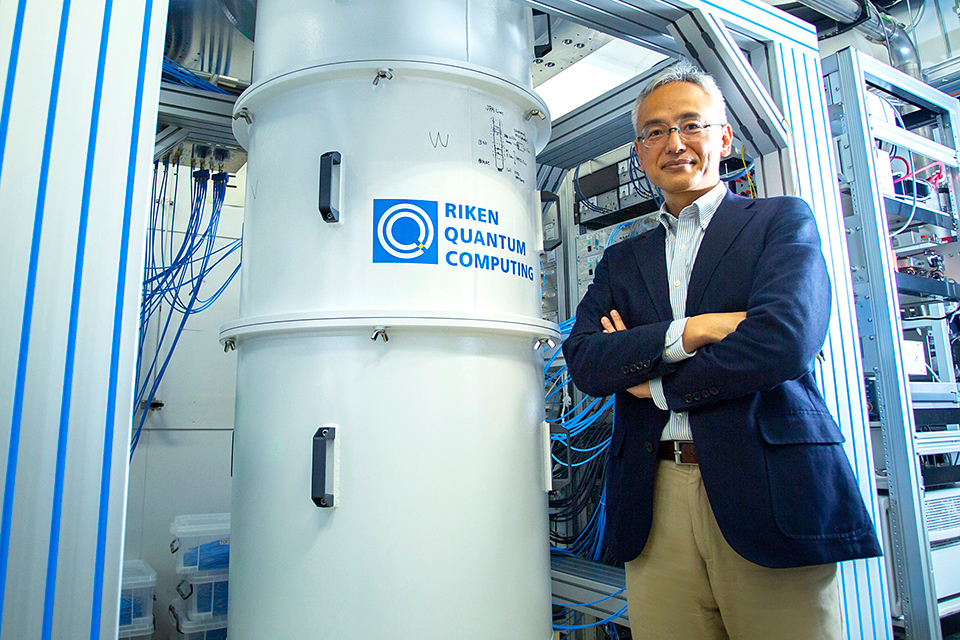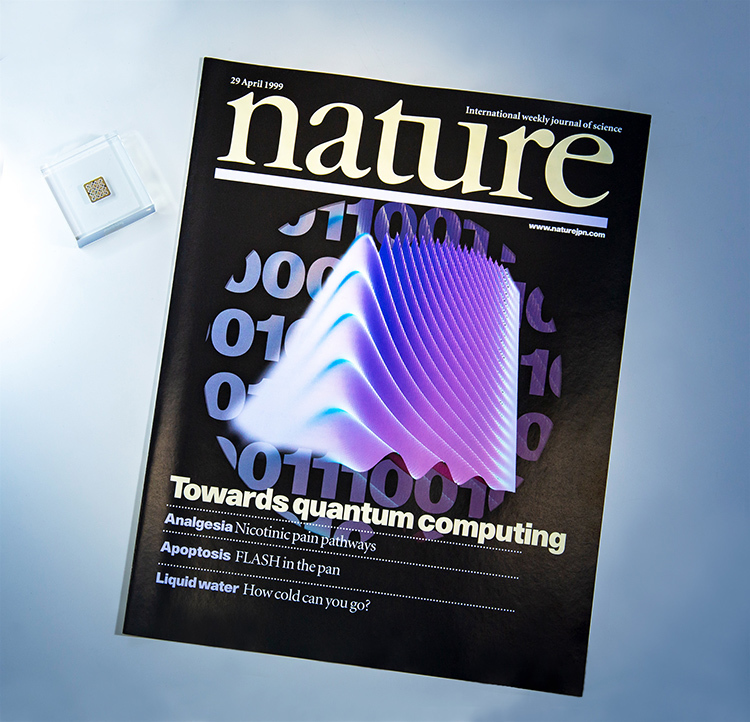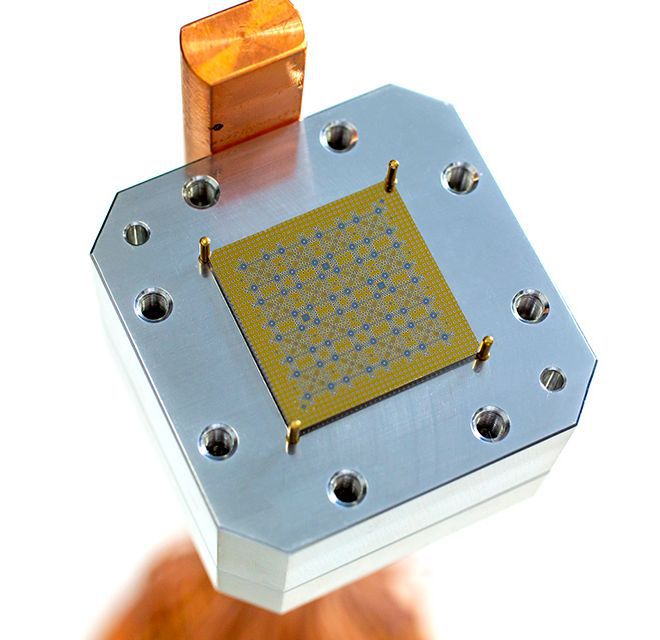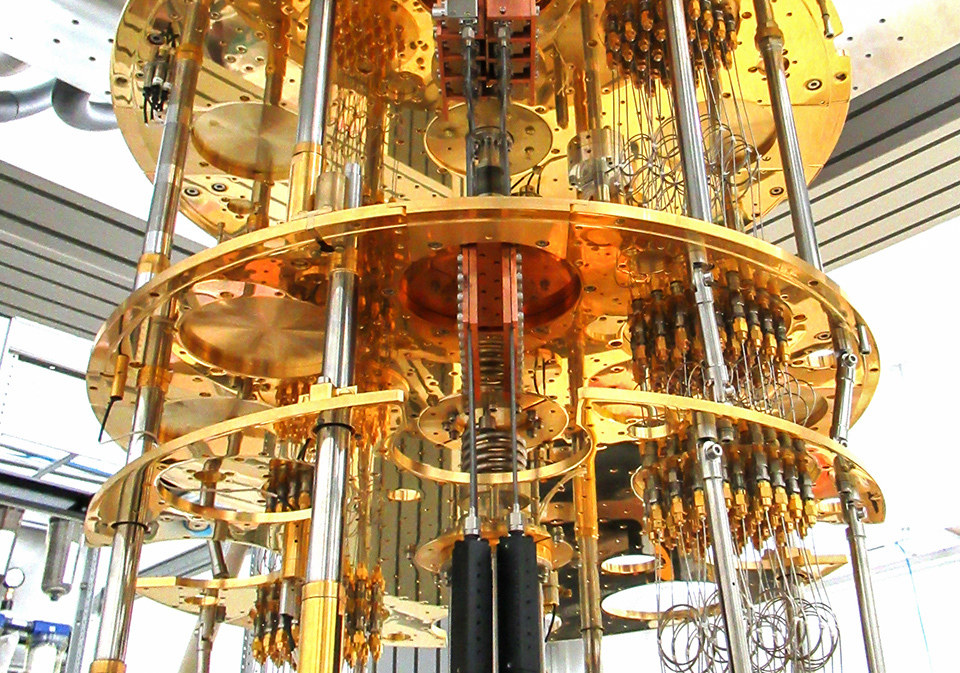Quantum computing—once considered a distant dream—is now in the initial stages of becoming a reality. Amid the fierce global competition to develop the technology, the Government of Japan has formulated the Vision of Quantum Future Society in April of this year, and is accelerating R&D in that field. A researcher who paved the way to its practical use with his world-first breakthrough 20 years ago talks about the outlook for quantum technology.

Dr. NAKAMURA Yasunobu poses alongside RIKEN’s superconducting quantum computer. He produced superconducting qubits when he was a researcher at NEC Corporation’s Basic Research Laboratories. Dr. Nakamura is now director of RIKEN Center for Quantum Computing and a professor at the University of Tokyo’s Department of Applied Physics, Graduate School of Engineering.

The April 29, 1999, edition of Nature that published Dr. Nakamura’s paper. The cover features an illustration of a superconducting qubit measurement signal. On the left is a superconducting qubit chip.

A 64-bit superconducting qubit chip, measuring about 2cm on each side. It is mounted onto a wiring package that connects to the quantum computer.
In 1999, a paper published in the journal Nature amazed and encouraged researchers around the world, having demonstrated the realistic possibility of creating a working quantum computer for the first time ever. The paper described the world’s first successful attempt at developing superconducting quantum bits (qubits), which act as the heart of a quantum computer. Through that breakthrough, the microscopic world of quantum mechanics, normally invisible to the human eye, was realized on a macro scale in the form of an electrical circuit. The technology’s developer, Dr. NAKAMURA Yasunobu, said, “In the laboratory, I witnessed a phenomenon nobody had seen before. It was truly gratifying for a researcher such as myself.”

The April 29, 1999, edition of Nature that published Dr. Nakamura’s paper. The cover features an illustration of a superconducting qubit measurement signal. On the left is a superconducting qubit chip.

A 64-bit superconducting qubit chip, measuring about 2cm on each side. It is mounted onto a wiring package that connects to the quantum computer.
A quantum computer that performs calculations with quantum mechanics could be far more powerful than the latest supercomputer. In recent years, governments around the world have been formulating national strategies and putting effort into developing the quantum technology. Likewise, the Government of Japan considers quantum computing a core element of the growth strategy under the Kishida administration’s New Form of Capitalism.
In 2020, the government laid forth the Quantum Technology and Innovation Strategy, and the following year, established eight new R&D centers to facilitate collaboration and accelerate research. Dr. Nakamura is the director of one of these, RIKEN Center for Quantum Computing. The center’s work follows a full-stack approach—from hardware to software and from basic science to application—thus covering broad aspects of R&D. He says, “At our current stage, we have produced a prototype, which was unthinkable two decades ago,” and adds, “The progress of humanity’s wisdom and technology feels tangible to me.”
In April 2022, the Japanese government formulated a new strategy, named the Vision of Quantum Future Society, that expanded on the initiatives for social innovation through quantum technology from the 2020 strategy. It aims for society’s positive evolution by embedding quantum technology throughout social and economic systems, which will create opportunities for industrial growth and a carbon-neutral society, as well as addressing social issues such as those raised by the SDGs.
For several years already, a number of foreign companies have been operating cloud services powered by quantum computing. Japan is also making practical applications in the area a reality, as the government’s strategy calls for the country to produce its first domestically manufactured quantum computer by March of next year.

The inside of the superconducting quantum computer. Superconducting qubits only function in a state of superconductivity, in which electrical resistance disappears. They are stored in a cooling device that produces the superconducting state and reduces errors by lowering the temperature to near absolute zero (−273.15ºC + 0.01ºC). RIKEN CENTER FOR QUANTUM COMPUTING
However, human society is still at the dawn of the quantum computing era. Current quantum computers are limited in what they can do as they cannot churn out accurate calculations, owing to the fact that they produce errors after a certain amount of computation. The eventual goal is a fault-tolerant quantum computer that reduces errors during the computing process, while correcting any new ones that do arise. With researchers across the globe facing an enormous number of challenges, Japan’s goal is to produce such a device by 2050.
Dr. Nakamura says that Japan’s advantage in quantum computing comes from “consistently and steadily conducting basic research, and accumulating results.” In addition to his development of superconducting qubits, Japan also developed the concept of quantum annealing—one of the principles behind quantum computing—underpinning the country’s contribution to basic research on quantum technology. In the future, Japan will accelerate R&D so as to stand shoulder-to-shoulder with the world’s leaders in industrializing the technology.
“The new field of quantum technology faces a global challenge—that of developing talent. I would like us to achieve advances in quantum technology and eventually develop a quantum computer by enlarging our circle of collaboration to include people working in different fields, not only in Japan, but also throughout the entire world.”






























